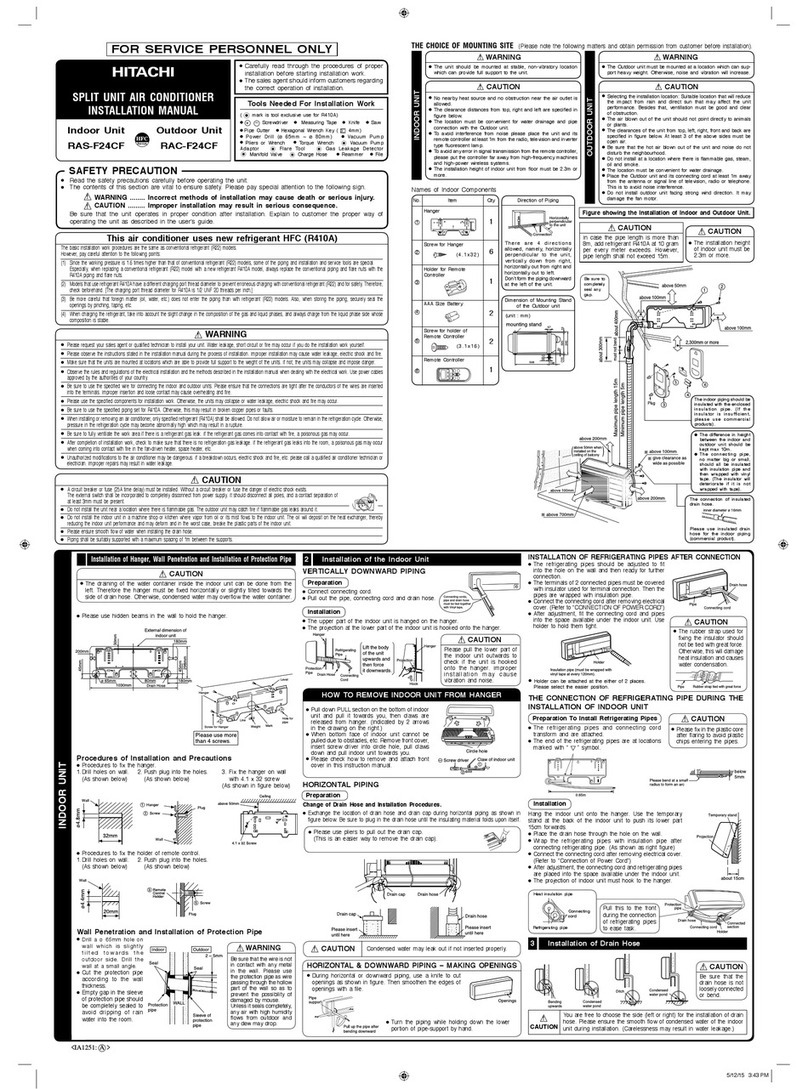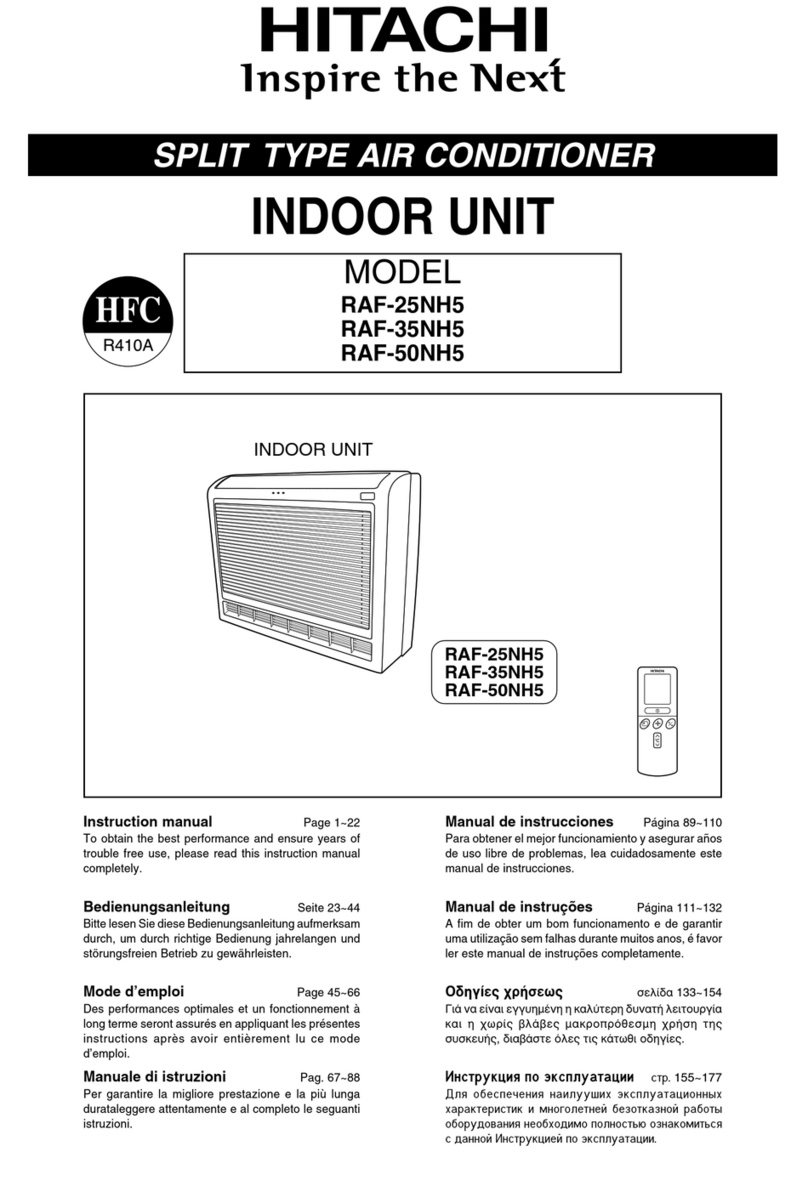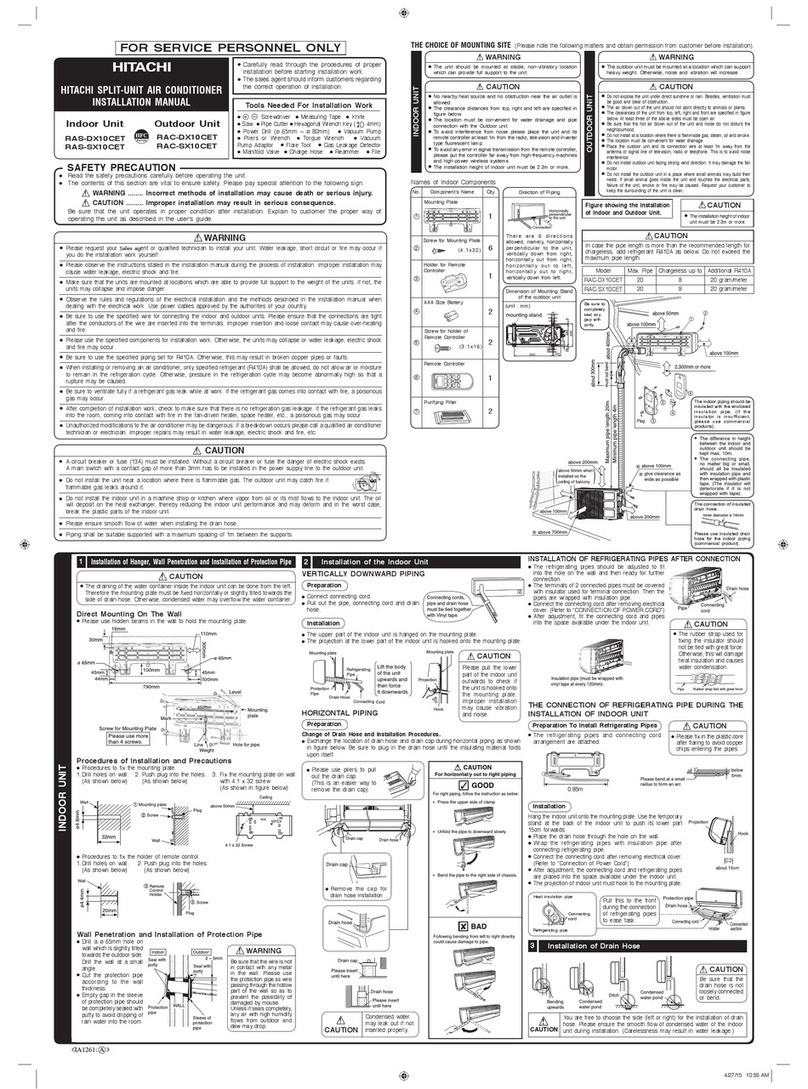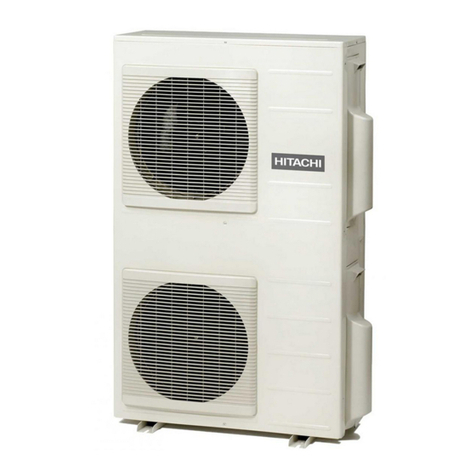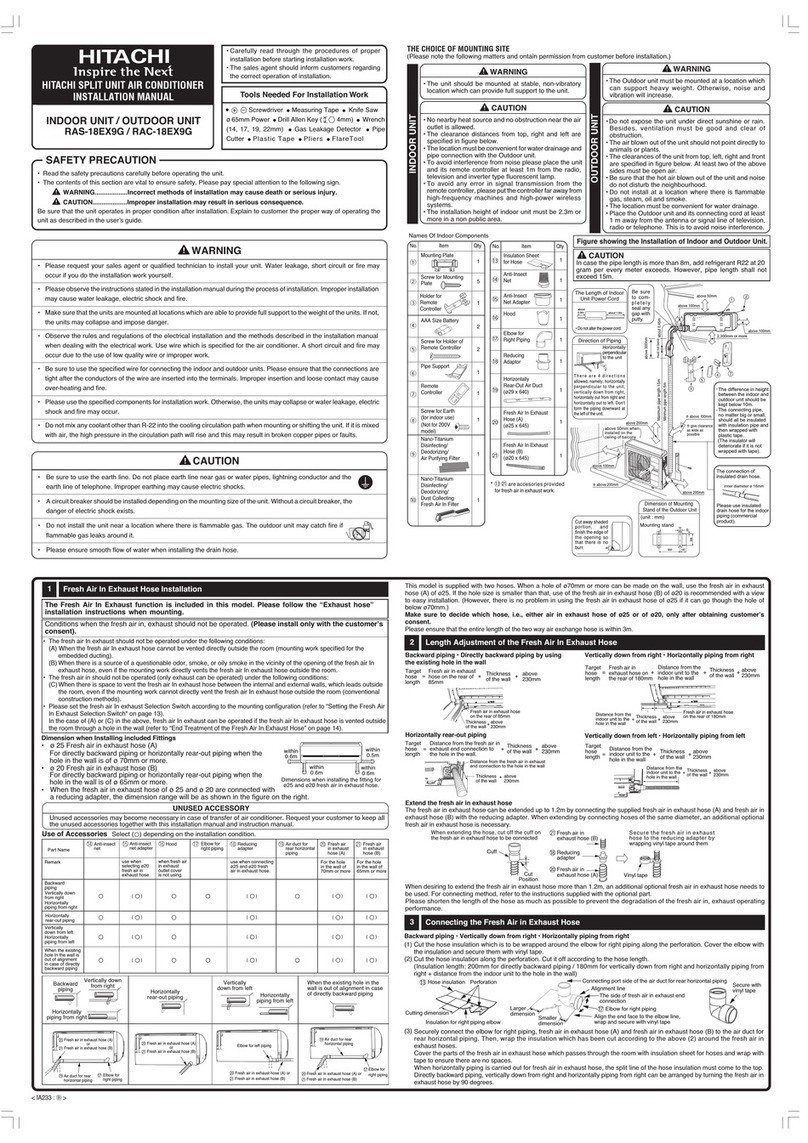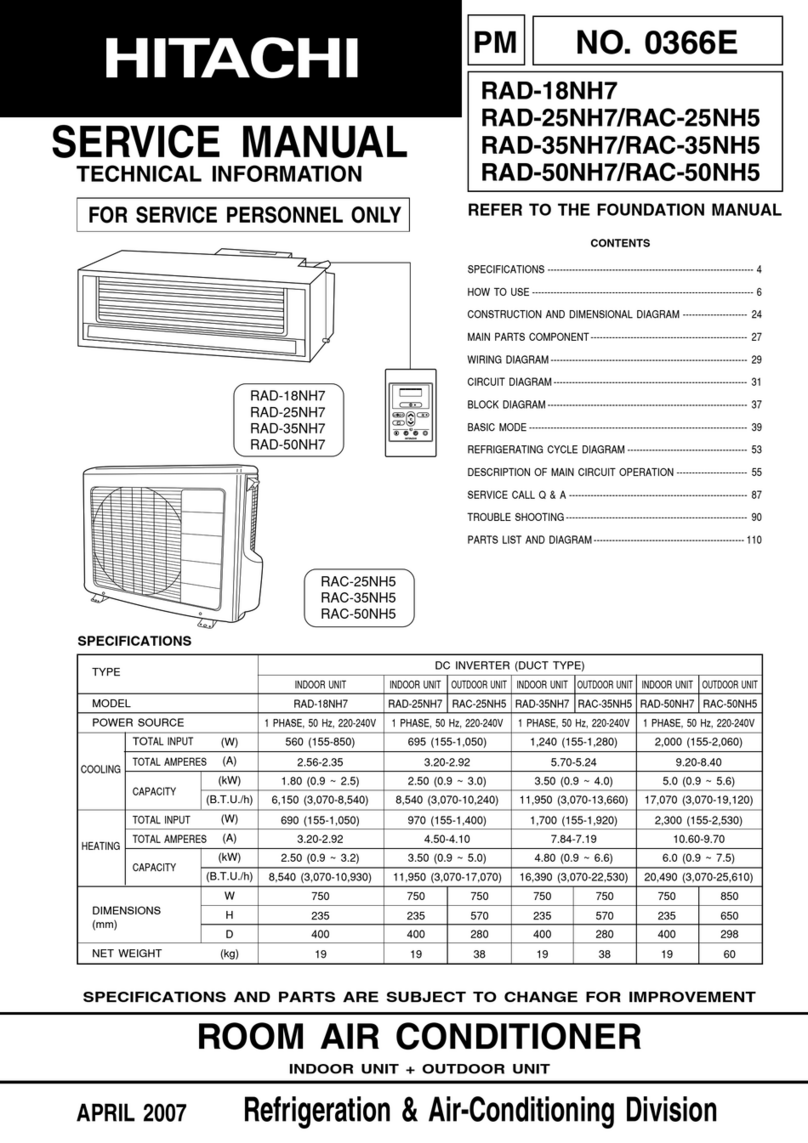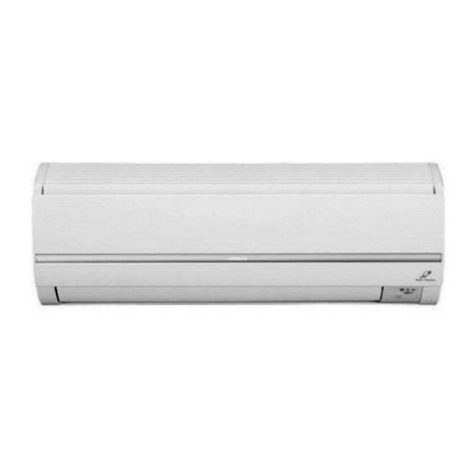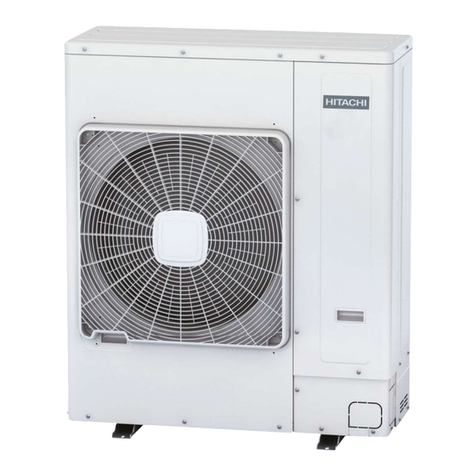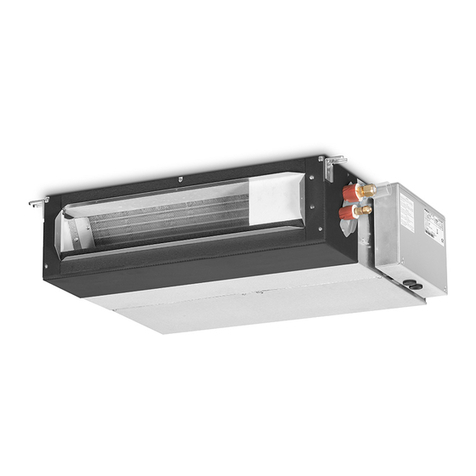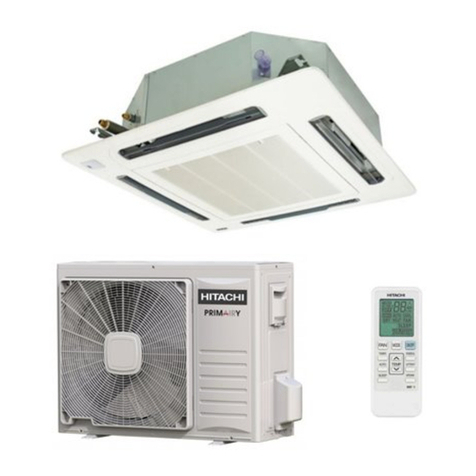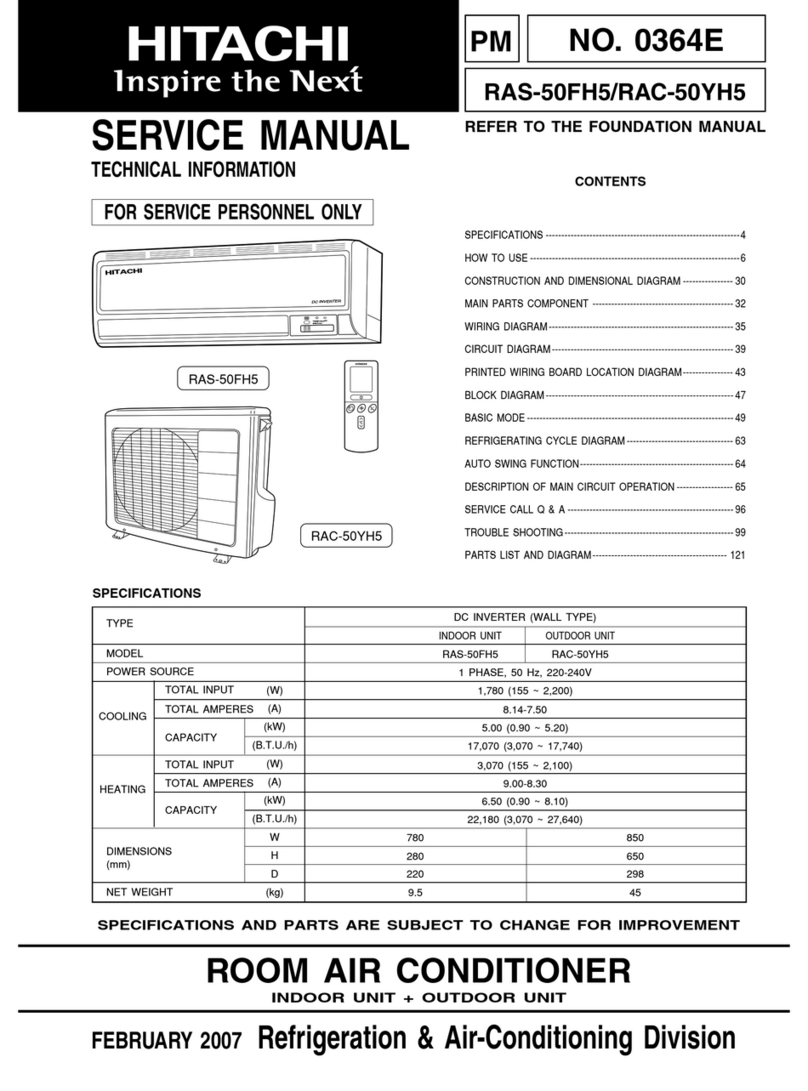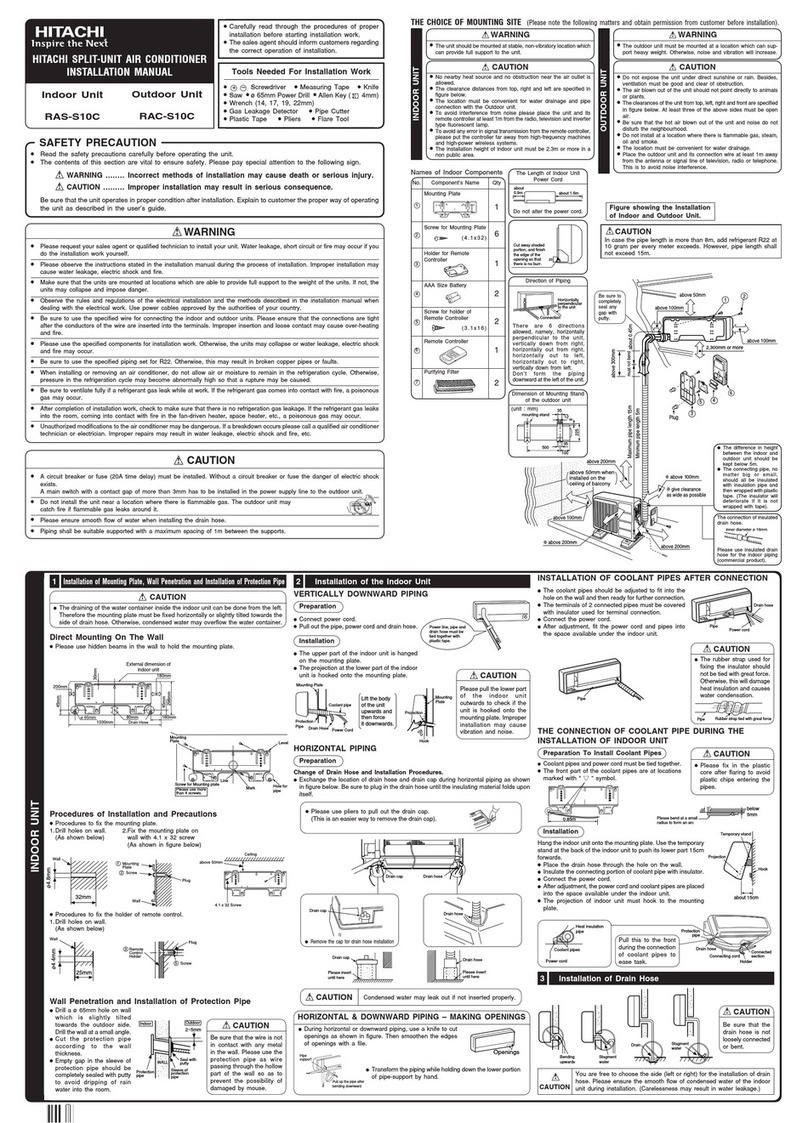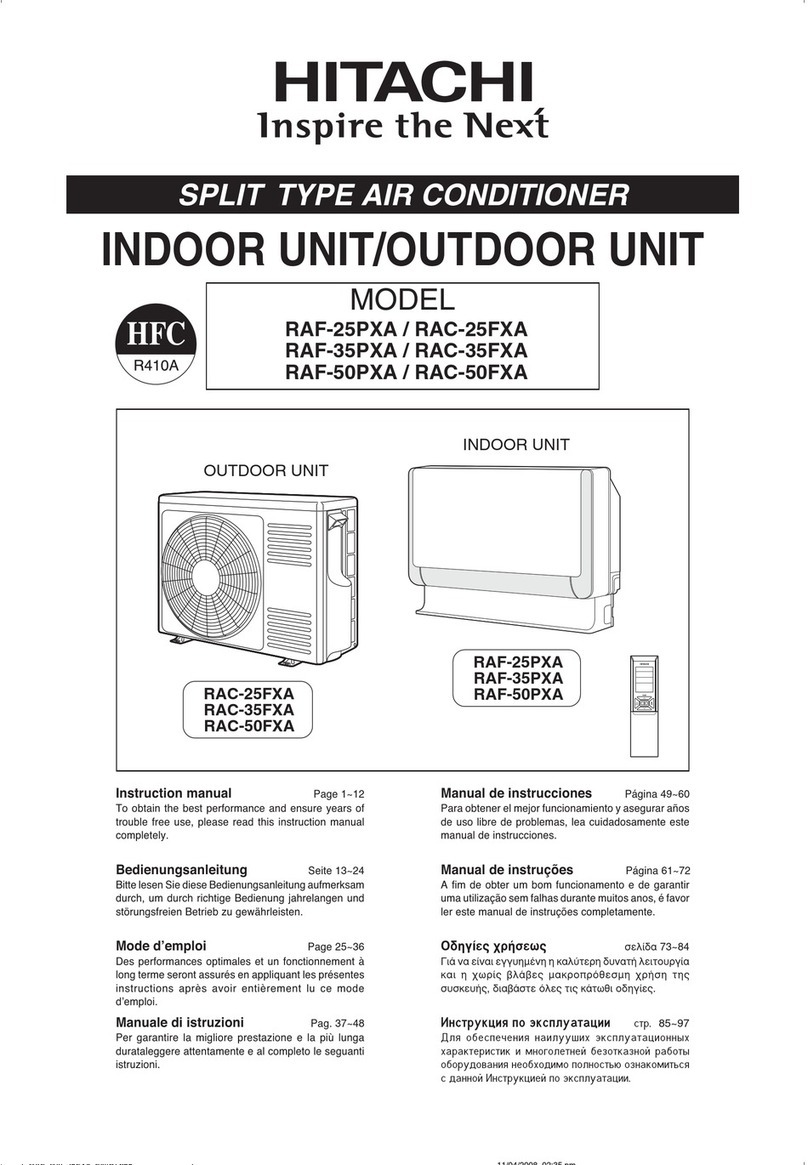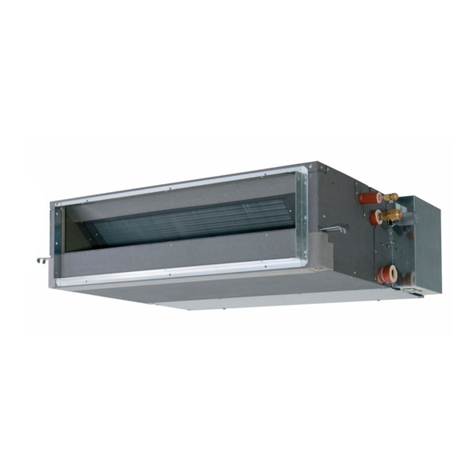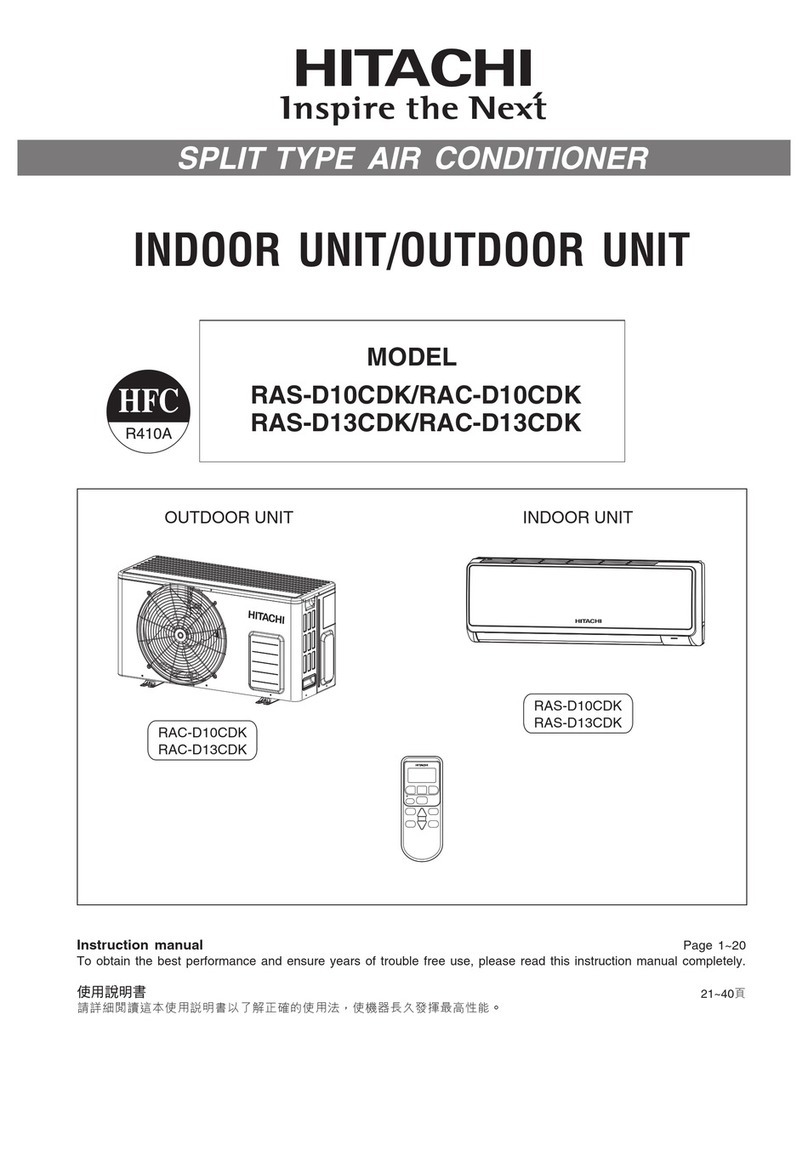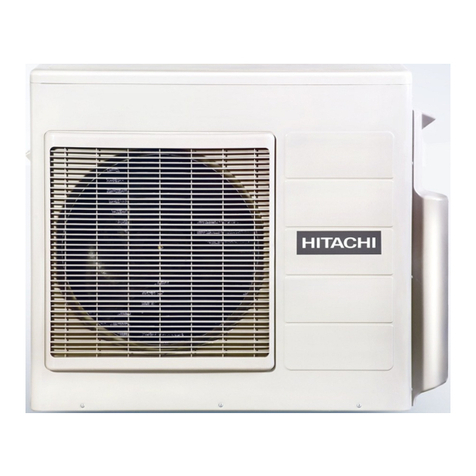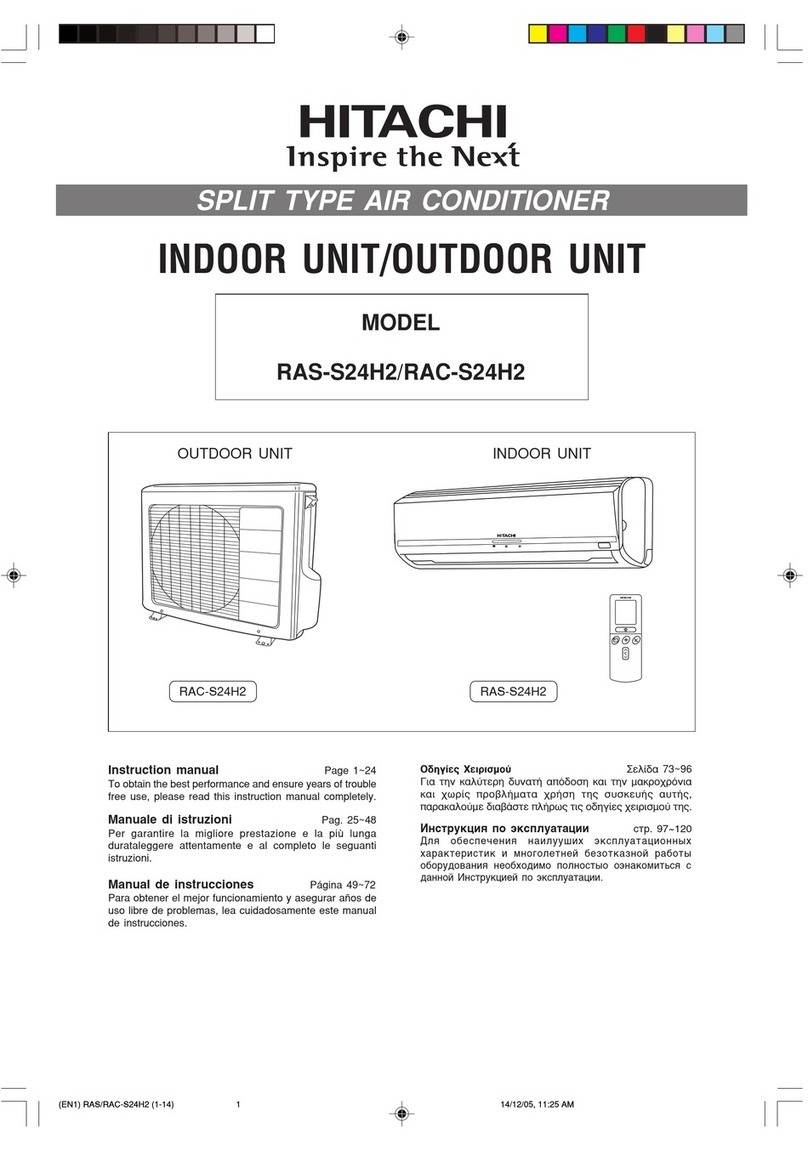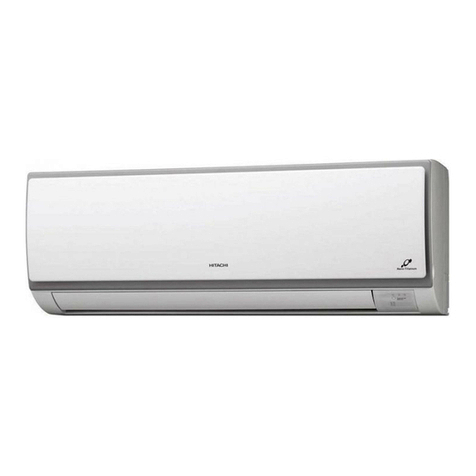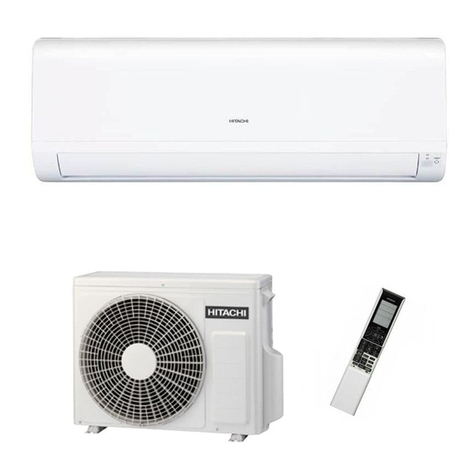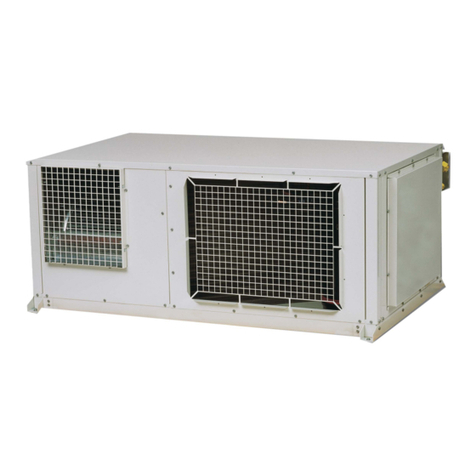
The Choice of Mounting Site
(Please note the following matters and obtain permission from customer before installation).
WARNING
!
●The unit should be mounted at stable, non-vibratory location
which can provide full support to the unit.
CAUTION
!
●No nearby heat source and no obstruction near the air outlet is
allowed.
●The clearance distances from top, right and left are specified in
figure below.
●The location must be convenient for water drainage and pipe
connection with the Outdoor unit.
●To avoid interference from noise please place the unit and its
remote controller at least 1m from the radio, television and inverter
type fluorescent lamp.
●To avoid any error in signal transmission from the remote controller,
please put the controller far away from high-frequency machines
and high-power wireless systems.
●The installation height of indoor unit must be 2.3m or more.
INDOOR UNIT
Direction of Piping
There are 4 directions
allowed, namely, vertically
down from right, horizontally
out from right, horizontally
out to left, horizontally out
to right.
●The difference in height
between the indoor and
outdoor unit should be kept
max 20m.
●The connecting pipe, no
matter big or small, should all
be insulated with insulation
pipe and then wrapped with
vinyl tape. (The insulator
will deteriorate if it is not
wrapped with tape).
The connection of insulated
drain hose.
Please use insulated drain
hose for the indoor piping
(commercial product).
The indoor piping should be
insulated with the enclosed
insulation pipe. (If the insulator
is insufficient, please use
commersial products).
Be sure to
completely
seal any
gap with
putty.
Installation of Mounting Plate, Wall Penetration and Installation of Protection Pipe
1
CAUTION
!
●The draining of the water container inside the indoor unit can be done from the left.
Therefore the mounting plate must be fixed horizontally or slightly tilted towards the
side of drain hose. Otherwise, condensed water may overflow the water container.
Direct Mounting On The Wall
●Please use hidden beams in the wall to hold the mounting plate.
Wall Penetration and Installation of Protection Pipe
●Drill a ø 65mm hole on
wall which is slightly tilted
towards the outdoor side.
Drill the wall at a small
angle.
●Cut the protection pipe
according to the wall
thickness.
●Empty gap in the sleeve
of protection pipe should
be completely sealed with
putty to avoid dripping of
rain water into the room.
Installation of the Indoor Unit
2
VERTICALLY DOWNWARD PIPING
Preparation
●Connect connecting cord.
●Pull out the pipe, connecting cord and drain hose.
Installation
●The upper part of the Indoor unit is hanged on the mounting plate.
●The projection at the lower part of the Indoor unit is hooked onto the mounting plate.
Please pull the lower part of
the Indoor unit outwards to
check if the unit is hooked onto
the mounting plate. Improper
installation may cause vibration
and noise.
!
CAUTION
INSTALLATION OF REFRIGERATING PIPES AFTER CONNECTION
●The refrigerating pipes should be adjusted to fit into the hole on the wall and then
ready for further connection.
●The terminals of 2 connected pipes must be covered with insulator used for terminal
connection. Then the pipes are wrapped with insulation pipe.
●Connect the connecting cord after removing electrical cover. (Refer to “CONNECTION
OF POWER CORD”)
●After adjustment, fit the connecting cord into the space available under the indoor
unit.
!
CAUTION
●
The rubber strap used
for fixing the insulator
should not be tied with
great force. Otherwise,
this will damage heat
insulation and causes
water condensation.
THE CONNECTION OF REFRIGERATING PIPE DURING THE
INSTALLATION OF INDOOR UNIT
Preparation To Install Refrigerating Pipes
!
CAUTION
●Please fix in the plastic core
after flaring to avoid copper
chips entering the pipes.
CAUTION
!
You are free to choose the side (left or right) for the installation of drain hose.
Please ensure the smooth flow of condensed water of the Indoor unit during
installation. (Carelessness may result in water leakage.)
!
CAUTION
Be sure that the drain
hose is not loosely
connected or bend.
Be sure that the wire is not
in contact with any metal
in the wall. Please use
the protection pipe as wire
passing through the hollow
part of the wall so as to
prevent the possibility of
damaged by mouse.
Unless it seals completely,
any air with high humidity
flows from outdoor and
any dew may drop.
!
WARNING
●Refer to below diagram for the connecting refrigerating
pipes and cord arrangement.
Installation of Drain Hose
3
Installation
Hang the Indoor unit onto the mounting plate. Use the temporary stand
at the back of the Indoor unit to push its lower part 15cm forwards.
●Place the drain hose through the hole on the wall.
●Wrap the refrigerating pipes with insulation pipe after connecting
refrigerating pipe.
●Connect the connecting cord after removing electrical cover. (Refer
to “Connection of Power Cord”)
●After adjustment, the connecting cord and refrigerating pipes are
placed into the space available under the Indoor unit.
●The projection of Indoor unit must hook to the mounting plate.
INDOOR UNIT
Heat insulation pipe
Connecting
cord
Refrigerating pipe
Pull this to the front
during the connection
of refrigerating pipes
to ease task.
HOW TO REMOVE INDOOR UNIT
●
Push up the (PUSH) sections at the bottom of the indoor
unit and pull the bottom plate towards you. Then the claws
are released from the stationary plate.
(The (PUSH) sections are indicated by 2 arrows in the
right figure)
Procedures of Installation and Precautions
●Procedures to fix the mounting plate.
1.Drill holes on wall. 2. Push plug into the holes. 3. Fix the mounting plate on
(As shown below) (As shown below) wall with 4.1 x 32 screw
(As shown in figure below)
●Procedures to fix the holder of remote control.
1.Drill holes on wall. 2. Push plug into the holes.
(As shown below) (As shown below)
Horizontally
perpendicular
to the unit
Connection
above 50mm
above 100mm
above 100mm
Plug
2,300mm or more
above 300mm
above
400mm
must not bend
Maximum pipe length 30m
Minimum pipe length 3m
inner diameter ø 16mm
Level
Mounting
plate
Hole for pipe
Line
Weight
Mark
Screw for Mounting Plate
Please use more than
4 screws.
Plug
Screw
Remote
Control
Holder
20mm
ø4.4mm ø4.8mm
Wall
Wall
32mm Wall
Mounting plate
Screw Plug
4.1 x 32 Screw
above 50mm
Ceiling
1
2
3
5
Indoor Outdoor
WALL
Sleeve of
protection pipe
Protection
pipe
Seal with
putty
Seal with
putty
2 ~ 5mm
Connecting cords, pipe and
drain hose must be laid
together with Vinyl tape.
Mounting plate
Drain Hose
Protection
Pipe
Refrigerating
Pipe
Connecting
Cord
Lift the body
of the unit
upwards and
then force it
downwards.
Mounting plate
Projection
[Push] mark positions
Drain cap Drain hose
Drain hose
Connecting cord
Pipe
Pipe Rubber strap tied with
great force
Please bend at a small
radius to form an arc
below
5mm
Projection
Hook
about 15cm
Protection pipe
Drain hose
Connecting cord
Holder Connected
section
Bending
upwards
Condensed
water pond
Ditch Condensed
water pond
Figure showing the Installation of Indoor Unit.
●This unit is chargeless up 30m pipe length.
●Installation of pipe length less than minimum pipe length
requirement (3 meters) may generate an abnormal sound.
CAUTION
Drain cap
HORIZONTAL PIPING
Preparation
Change of Drain Hose and Installation Procedures.
●
Exchange the location of drain hose and drain cap during horizontal piping as shown in
figure below. Be sure to plug in the drain hose until the insulating material folds upon itself.
●Please use pliers to pull
out the drain cap.
(This is an easier way to
remove the drain cap).
CAUTION
Condensed water
may leak out if not
inserted properly.
●Remove the cap for
drain hose installation
Drain cap shall
be fully tightened
by pushing with
Hexagonal wrench
key when changing
location.
CAUTION
For horizontally out to right piping
GOOD
For right piping, follow the instruction as below:
●
Press the upper side of clamp
●
Unfold the pipe to downward slowly.
●
Bend the pipe to the right side of chassis.
BAD
Following bending from left to right directly
could cause damage to pipe.
Drain hose
Drain hose
Please insert
until here
CAUTION
●
Do not guide the drain hose to places where corrosive gases (sulfur, ammonia,
etc.) are generated, such as septic tanks and sewer.
Corrosive gas may flow backward from the drain hose to the indoor unit, corrode
the copper pipe, or it may cause offensive odors in the room.
●
Cut the drain hose at a position 100 mm higher than the floor surface. It may
cause water leakage due to air lock or clogging of foreign matter.
Above
100mm
!
BURST HAZARD
Do not allow air, etc. to get into
refrigerant cycle (piping)
RISK OF EXPLOSION
Compressor must be stopped
before removing refrigerant
pipes.
All service valve must be fully
closed after pumping down
operation.
WARNING
WARNING
CAUTION
CAUTION
CAUTION
This symbol shows that this equipment uses a
flammable refrigerant.
If the refrigerant is leaked, together with an external
ignition source, there is a possibility of ignition.
This symbol shows that the Operation Instructions
should be read carefully.
This symbol shows that a service personnel should
be handling this equipment with reference to the
Installation Manual.
This symbol shows that there is information included
in the Operation Manual and/or Installation Manual.
Refrigerant piping
must be protected
from physical
damage. Install a
plastic cover or
equivalent.
Flare connection only at
outside of building
WARNING
Table 1: Minimum Floor area of the room Amin (m2)
Minimum Floor area of the room
Amin (m2)
RAS-E60YHAB
Max Refrigerant
Charge Amount
(g)
Max Piping
Length
(m)
Outdoor
Model
RAC-E60YHAB 30 1500 2.15
●Do not use means to accelerate the defrosting process or to clean, other than those recommended by the manufacturer.
Any unfit method or using incompatible material may cause product damage, burst and serious injury.
●The appliance/pipe-work shall be stored in a well ventilated room with indoor floor area larger than Amin [refer to Table
1] and without any continuously operating ignition source. Keep away from open flames, any operating gas appliances
or any operating electric heater. Else, it may explode and cause injury or death.
●The appliance/pipe-work shall be installed, and/or operated in a room with floor area larger than Amin [refer to Table
1] and keep away from ignition sources, such as heat/spark/open flame or hazardous areas such as gas appliances,
gas cooking, reticulated gas supply systems or electric cooking appliances, etc.
●Do not pierce or burn as the appliance/pipe-work is pressurized. Do not expose the appliance/pipe-work to heat,
flame, sparks, or other sources of ignition. Else, it may explode and cause injury or death.
WARNING
Screw for Mounting
Plate
(4.1x32)
Names of Indoor Components
Screw for holder of
Remote Controller
(3.1x16)
AAA Size Battery
Holder for Remote
Controller
Mounting Plate
QtyNo. Component’s Name
1
6
1
2
2
Remote Controller
Purifying Filter
1
2
3
4
5
6
7
1
2
!
!
1
Bush
Names of Outdoor Components
Qty
No. Item
1
Drain Pipe
Bush
3
8
9
10
Tools Needed For Installation Work
●Carefully read through the procedures of
proper installation before starting installation
work.
●The sales agent should inform customers
regarding the correct operation of installation.
(mark is tool exclusive use for R32)
●+ – Screwdriver ●Measuring Tape
●Knife ●Saw ●Pipe Cutter
●Hexagonal Wrench Key ( 4mm)
●Power Drill (ø 65mm ~ ø 80mm)
Vacuum Pump ●Pliers or Wrench
●Torque Wrench Vacuum Pump Adaptor
●Flare Tool ●Gas Leakage Detector
Manifold Valve Charge Hose
●Reamer ●File
<
IA1951: C
>
SAFETY PRECAUTION
●Read the safety precautions carefully before operating the unit.
●The contents of this section are vital to ensure safety. Please pay special attention to the following sign.
WARNING ........ Incorrect methods of installation may cause death or serious injury.
CAUTION ......... Improper installation may result in serious consequence.
Be sure that the unit operates in proper condition after installation. Explain to customer the proper way of operating
the unit as described in the user’s guide.
!
Refrigerant pipe size (outer diameter): Narrow pipe, Liquid (ø6.35mm); Wide pipe, Gas (ø12.70mm)
●Flare nut must use a torque wrench without fail. Tighten with the specified tightening torque. If
the flare nut is tightened too much, after a long period of time, the flare nut breaks, Gas leakage,
stagnation, touching fire, rarely cause ignition.
●Sharp bending of the pipe use the polyethylene rod, bend not crushed the pipe. Gas leakage from
the crushed part, stagnation, touching fire, rarely cause ignition.
●Please request your sales agent or qualified technician to install your unit. Water leakage, short
circuit or fire may occur if you do the installation work yourself.
●Please observe the instructions stated in the installation manual during the process of installation.
Improper installation may cause water leakage, electric shock and fire.
●A brazed, welded, or mechanical connection shall be made before opening the valves to permit
refrigerant to flow between the refrigerating system parts. A vacuum valve shall be provided to
evacuate the interconnecting pipe and/or any uncharged refrigerating system part.
●Mechanical connectors used indoors shall comply with ISO 14903. When mechanical connectors
are reused indoors, sealing parts shall be renewed. When flared joints are reused indoors, the
flare part shall be re-fabricated.
●Refrigerant tubing shall be protected or enclosed to avoid damage.
●Make sure that the units are mounted at locations which are able to provide full support to the
weight of the units. If not, the units may collapse and impose danger.
●Observe the rules and regulations of the electrical installation and the methods described in the
installation manual when dealing with the electrical work. Use power cables approved by the
authorities of your country.
●Be sure to use the specified wire for connecting the indoor and outdoor units. Please ensure that
the connections are tight after the conductors of the wire are inserted into the terminals. Improper
insertion and loose contact may cause over-heating and fire.
●Please use the specified components for installation work. Otherwise, the units may collapse or
water leakage, electric shock and fire may occur.
●Be sure to use the specified piping set for R32. Otherwise, this may result in broken copper pipes
or faults.
●When installing or removing an air conditioner, only specified refrigerant (R32) shall be allowed, do
not allow air or moisture to remain in the refrigeration cycle. Otherwise, pressure in the refrigeration
cycle may become abnormally high so that a rupture may be caused.
●Be sure to ventilate fully if a refrigerant gas leak while at work. If the refrigerant gas comes into
contact with fire, a poisonous gas may occur. Be aware that refrigerants may not contain an odour.
●After completion of installation work, check to make sure that there is no refrigeration gas leakage.
If the refrigerant gas leaks into the room, coming into contact with fire in the fan-driven heater,
space heater, etc., a poisonous gas may occur.
●Unauthorized modifications to the air conditioner may be dangerous. If a breakdown occurs please
call a qualified air conditioner technician or electrician. Improper repairs may result in water leakage,
electric shock and fire, etc.
●A circuit breaker or fuse must be installed. Without a circuit breaker or fuse the danger of electric
shock exists.
The external switch shall be incorporated to completely disconnect from power supply. It should
disconnect all poles, and a contact separation of at least 3mm must be present.
●Do not install the unit near a location where there is flammable gas. The outdoor unit may catch
fire if flammable gas leaks around it.
●Do not install the indoor unit in a machine shop or kitchen where vapor from oil or its mist flows
to the indoor unit. The oil will deposit on the heat exchanger, thereby reducing the indoor unit
performance and may deform and in the worst case, break the plastic parts of the indoor unit.
●Please ensure smooth flow of water when installing the drain hose.
●Piping shall be suitable supported with a maximum spacing of 1m between the supports.
CAUTION
INSTALLATION
MANUAL
SPLIT UNIT AIR CONDITIONER
INDOOR UNIT
RAS-E60YHAB
OUTDOOR UNIT
RAC-E60YHAB
EN INSTRUCTION MANUAL
FOR SERVICE
PERSONNEL ONLY
<IA1951: C >
